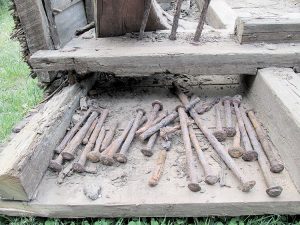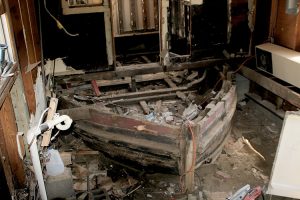By Jay Cook
It is not everyday that a piece of history is discovered underneath someone’s house, let alone holding that house up.
But this odd occurrence was a reality for Eileen Scanlon of 5th Street in Highlands, who discovered on May 26 exactly what was beneath the floorboards of a three-bedroom bungalow on her property.
What she found was a 44-foot vessel, constructed of white oak and pieced together by iron nails, dating back to the mid-19th century. It measured 12 feet across, and was found mostly intact, rudder and all.
Scanlon, who lives with her husband Mike in the main house on their plot, also owns a third rentable unit just behind their residence. They have been living here at 5th Street since 2010, when they purchased the three-house lot. She had always been aware of something under the bungalow.
“I knew there was a boat under there because we had seen it—but nobody had any idea it was almost 50 feet long and that it was forming the foundation of the house,” she said.

and a half in length, held the vessel together.
That particular Tuesday morning was quite hectic, beginning with a visit from her architect, Cathy Franco. “She came down because she was worried about the beams and how they were going to deal with putting it back on the foundation—architectural stuff,” said Scanlon. Next thing she knew, Franco was calling her at 8 a.m. to come outside and see what the crew on site had exposed.
Once the discovery had been made, construction to the bungalow was stopped for three days. Although the work had come to a temporary halt, an influx of sightseers had just begun.
“I’m taking pictures to send back to my family in Ireland,” said Patrick O’Flaherty, 56, of Middletown. “I saw it on the web this morning and said ‘Oh my God I know where that house is.’”
While the general public had just learned of the ship, Scanlon was not the only local to know of its existence. Claire Stelios, 59, of Highlands, has her own vivid memories of the vessel.
“I was 11 when I moved to this property,” Stelios said, pointing to Scanlon’s yard. She spent ten years of her adolescent life living there, her family renting from former proprietor Jack Elia. “I knew it, and so did the previous owner. When he fixed the bungalows, what they found in there was a lot of liquor bottles.”

Claims of the boat’s past usage have floated around from a rum-running ship to a transportation vessel, but local historian Russell Card put those to rest. “When I went over there I saw it was indeed a barge that used to bring seafood into market,” said Card, president of the Historical Society of Highlands. He was one of the first people on site Tuesday after the barge had been revealed.
“The Historical Society has known for a number of years,” Card said. “We always figured it was just a boathouse that they pulled up on the beach, but it turned out to be something older than that.”
A former Highlands Council member also first saw the boat in May of 2008. “I live two doors away and the previous owner was doing some work, and they asked my advice because they saw the boat,” said Chris Francy, the 73-year-old Highlands resident.
“The floor was sagging that had been built on top of it, and they had to restore it,” he recalled. When Francy saw what was under the house, he went home to grab his camera and take a few photographs.
While it had been reported that coal had been found on the boat, Scanlon refuted those claims, saying that it had been another substance. “The coal turned out to be tar. The remnants we found are from tar buckets,” she said. “I had a historian come in afterwards and he cleared up a few misconceptions that were going around.”
The exact manner in which the boat reached its final resting place has come into question as well. Scanlon, who has family history in Highlands dating back to the early 20th century, offered her own take. “There was a sluiceway here, so we believe it went up the sluiceway. Why it stayed there, I don’t have any idea,” Scanlon said. She compared the former waterway on her property to another area similarly in Highlands – Snug Harbor.
In the days since its discovery, Scanlon reluctantly had to disassemble the barge to continue the house-lifting project. She did what she could to keep the vessel intact, with some help from the workers on site. A large portion of the bow was salvaged, along with the planks that made up the body of the boat.
Currently, everything sits in Scanlon’s side yard. The planks are stacked five feet high, and the bow sits in one solid piece a few feet off of her house. “We moved everything with three guys and a Bobcat,” she said.
So, what does Scanlon plan to do with her newfound piece of nautical history? She has bounced between a couple different ideas, one of them being the bow would become the centerpiece to her garden out back. She has also contemplated giving it to a museum, an idea that Card supports fully. “It’s her property, and I respect the property owner’s decision,” he said. “But I look at it from a different standpoint. I do see it as a loss to history in its own right. Something like that probably should be in a museum.”














